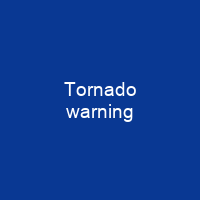A Tornado Warning: The Ultimate Call to Action
Imagine being in the direct path of a tornado, a swirling vortex of wind and debris that can destroy everything in its wake. A tornado warning is your last line of defense against this natural disaster. But what exactly does it mean? And how do meteorologists issue these critical alerts?
The Difference Between Watches and Warnings
A tornado watch means that conditions are favorable for the formation of tornadoes, but no actual tornado has been spotted yet. It’s like being in a stormy room where you can see dark clouds gathering on the horizon. A tornado warning, however, is more urgent—it means a tornado is either confirmed or strongly indicated by radar and/or ground reports.
How Tornado Warnings Are Issued
The first official tornado forecast was made in 1948 by US Air Force Capt. Robert C. Miller and Major Ernest Fawbush, who analyzed weather maps to predict a high risk of tornadic thunderstorms over Oklahoma. Their findings led to the issuance of a late warning that still saved lives despite some damages.
Modern technology has significantly improved tornado warnings. The National Weather Service uses Doppler radar to detect mesocyclones and debris signatures, which are key indicators of tornado formation. Ground truth from storm spotters, law enforcement, or emergency management also plays a crucial role in issuing these warnings.
Evolution of Tornado Warning Systems
The first experimental public tornado forecast was issued by the National Weather Service in 1952. This marked a significant shift from keeping such information confidential to sharing it with the general public. The American Meteorological Society further refined these methods, making them more accessible and effective.
Global Variations
In different regions, tornado warning systems vary. For instance, in Canada, warnings are issued through regional offices of the Meteorological Service, while Australia uses a multi-tiered system with categorical indicators for tornado and damage threats. Each country has its unique approach to ensure public safety.
Impact-Based Warning Systems
The National Weather Service’s Impact Based Warning System provides enhanced communication about severe weather phenomena. This system categorizes warnings based on the severity of potential impacts, helping people understand the urgency and take appropriate actions.
Real-World Examples
In 2019, a tornado warning was issued for northeastern Morris County in Kansas, with a confirmed tornado observed. The warning included specific instructions to seek shelter immediately due to potential damage from golf ball-sized hail and flying debris.
A similar warning was issued by the National Weather Service in Grand Rapids, Michigan, on August 24, 2023, for central Kent County. This warning highlighted the severe thunderstorm capable of producing a tornado and quarter-size hail, urging people to take cover now.
Conclusion
A tornado warning is not just a call to action; it’s a lifeline that can save lives. By understanding the difference between watches and warnings, staying informed through various communication channels, and taking immediate shelter when necessary, you can be better prepared for these dangerous storms.

You want to know more about Tornado warning?
This page is based on the article Tornado warning published in Wikipedia (retrieved on December 28, 2024) and was automatically summarized using artificial intelligence.






